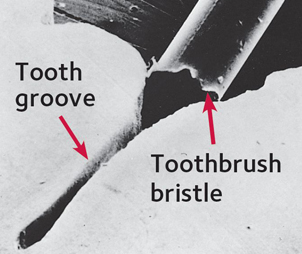380 Merrimack Street, Suite 3E, Methuen, MA 01844
- Call Us: 978-685-2511
380 Merrimack Street, Suite 3E, Methuen, MA 01844

Even a toothbrush bristle is too big to reach inside a groove in the tooth (magnified).
Tooth decay often begins on the chewing surfaces of the back teeth. These surfaces have pits and grooves that trap plaque, bacteria, and bits of food. The pits and grooves are hard to keep clean, because toothbrush bristles cannot reach into them.
That is how decay starts in the pits and grooves and cavities form. To keep decay from starting here, the dentist may recommend dental sealants.

Regular dental checkups and dental care-such as cleanings, fluoride treatments and sealants—provide your child with “smile insurance.” Plan your child’s first dental visit within six months after the first tooth appears but no later than the first birthday. Consider it a “well-baby checkup” for your child’s teeth.
At the dental visit, the dental team will:
Sports-related dental injuries can be prevented by wearing a mouthguard. Mouthguards can be custom-made by your dentist to fit your child’s mouth. Ready-made or “boil and bite” mouthguards are available at sporting goods stores. Ask your dentist which type is best for your child, especially if he or she wears braces.


Monday: 8am – 6pm
Tuesday: 8am – 6pm
Wednesday: Closed – By Appointment Only
Thursday: 8am – 6pm
Friday: 8am – 2pm
Saturday: Closed
Sunday: Closed
Methuen Dentist, Pleasant Valley Dental Health, is a dental professional dedicated to General, Family and Cosmetic Dentistry such as Dental Exams,
X-rays, Makeovers, Teeth Whitening, Implants, Root Canals, Veneers, Crowns, & more. Please come and visit our dental office in Methuen, MA.
We provide dental services in Boston MA, Methuen MA, Lawrence MA, Haverhill MA, North Andover MA, Andover MA, Milford MA, Lowell MA, Wilmington MA,
Wakefield MA, Chelmsford MA, Amesbury MA, Dracut MA, Reading MA, Tewksbury MA, Bedford MA, Billerica MA, Woburn MA, and other surrounding areas.
© 2024 – PLEASANT VALLEY DENTAL HEALTH – FAMILY & COSMETIC DENTISTRY – ALL RIGHTS RESERVED
DRS. GARY WAINWRIGHT & EDMAR UPITE – DENTIST IN METHUEN, MA
380 MERRIMACK STREET SUITE 3E METHUEN, MA 01844
TEL: 978-685-2511
EMAIL: INFO@METHUENDENTIST.COM